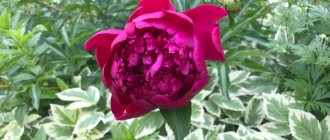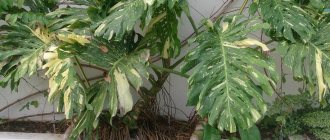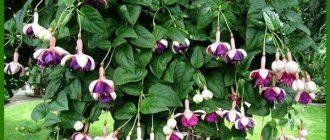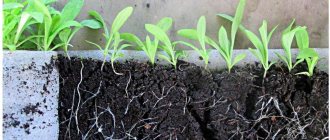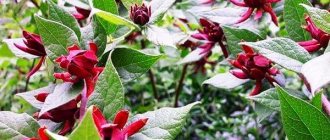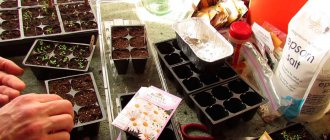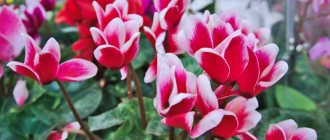Yellow daisies are pretty, compact flowers that are often used to create unique colorful arrangements in the garden. Moreover, in botany they are called doronicum. There are quite a few varieties of these plants. Each of them has certain characteristics.
Yellow daisies are beautiful flowers that are used in landscaping.
When and how to plant garden chamomile?
When it has been decided where in the dacha the chamomile will show off, they begin to plant it. The most favorable time for sowing seeds is the end of May. The top layer of soil is slightly loosened, since the seeds are very small, then shallow rows are made under them, no more than 2 cm, the soil is slightly moistened.
The seeds should not be covered heavily with soil; they should only be lightly pressed down, then sprinkled with a thin layer of soil.
In order for adult plants to feel free (usually a bush grows in one place for 3-4 years) and not shade each other, the distance between adjacent rows when sowing is made at least 30-40 cm.
You can plant chamomile seeds in open ground in the fall. At the end of August, you should collect seeds from the varieties you like, then sow them on a previously prepared site. The plant blooms only in the second year.
Caring for garden perennial daisies in the garden
What does a gardener need to know and do and how to properly care for daisies in the garden?
Not only newly planted seedlings, but also early seedlings in open ground need frequent watering. Initially, the young plant is watered very often, but when the root system takes root well and becomes stronger, it is watered less frequently, 2 times a week. After watering, constantly loosen the top layer of fertile soil, do not forget about weeding and removing weeds. Several times a season, the soil near the plant is mulched with a thin layer of peat, 2-3 cm thick.
There is an unspoken rule for growing daisies - the more often the bushes are watered and fertilized, the better and more abundantly they bloom.
Garden chamomile does not tolerate acidic soils well, so it is imperative to add slaked lime or dolomite flour to soil with an elevated pH balance. In addition, for proper nutrition of plants, you need to regularly add compost, peat and humus.
You can feed chamomile with nitrophoska. This is done in the spring, during the active growing season. The fertilizer is diluted in water at the rate of 2 tablespoons per 10 liters of water.
The largest flower among chamomile varieties - But its caps can also be made as large as possible by introducing timely fertilizing. Nivyaniki are very responsive to organic fertilizers. In addition, in the spring during the growing season, large-flowered varieties need to be fed with ammonium nitrate. The fertilizer is not embedded in the soil, but is scattered between the rows with an approximate calculation of 20g per 1m². No special watering is required after this.
You can re-apply urea during the period when the plant begins to form buds. However, this is done only if the foliage is pale in color. To avoid acidifying the soil with mineral fertilizers, add some nitrogen-containing substances. To do this, you can use both chemical mixtures and weak solutions of mullein or bird droppings.
To ensure abundant flowering from year to year, the bush needs to be rejuvenated every 4-5 years.
To do this, partial pruning of the root system is performed on one side of the plant. After three years, the same is done with the remaining part of the flower. In autumn, dried chamomile is cut before frost sets in. It needs to be covered for the winter.
Nielweed grows in one place for no more than 7 years. It requires periodic replanting. Strong growth harms the plant; it needs to be rejuvenated, in particular, to separate the bushes. Hybrid varieties need to be divided every three years.
Calendula or marigold (Calendula)
Everyone's favorite orange marigold flowers are unpretentious and easy to grow. Even one bush among other garden plants will definitely catch your eye - its color is so bright and saturated. It is worth planting marigolds once, and every year they will sprout earlier than other flowers - the seeds, falling off, are well preserved in the soil. During the season they can please you with flowering twice - the seeds germinate immediately and, if the autumn is warm, the young plant will bloom again.
Growing garden chamomile
Chamomile is an unpretentious plant
The only thing that matters to her is the sun. Most of all she loves open sunny areas, where the flowers are larger and elongated upward.
If you plant cornflower in the shade, the peduncle will be tall, the inflorescence will be small, and the flowering will be sparse.
With beautiful flowering, the cornflower will thank its owner for fertile soil, periodic loosening (if there is no mulch and a soil crust appears) and good watering. That is, for general care without any special hassle. The soil should not be allowed to dry out, as the plant does not tolerate drought well. Watering should be done in a timely manner, but moderately, so that there is no excess moisture. Large amounts of water can provoke the development of fungal diseases.
It is advisable to plant these flowers in a nutrient layer of soil (up to 30 cm), created with the help of organic fertilizers - compost, rotted manure. The optimal distance between seedlings is 35-40 cm.
Chamomiles are optimistic flowers that can lift your spirits. By planting them in your garden, you will bring only positivity to it. We hope you were interested in learning about the different types of garden daisies, and now you know the basic requirements for growing cornflower (ornamental chamomile).
Oh, daisies, daisies! Touching suns on legs, which our ancestors affectionately called belly buttons. Where did the current name come from? It is believed that it came from the Polish language (from “romana” - Roman), but romantics have their own version on this matter. There is a beautiful legend about a young man in love, Roman, who one day discovered at the head of his bed a delicate white flower that he had just seen in a dream. The delighted Roman hurried with a gift to the bride, but the beauty wanted every loving heart on earth to receive the same flower as hers. To fulfill the wish of his beloved, the young man set off on a long journey. Having overcome many obstacles, he came to the king of the land of dreams and told him his story. The Lord of Dreams promised to help, but in gratitude for this the brave man had to remain his prisoner forever. Meanwhile, a girl was waiting for her betrothed in her native land, but in vain... One day she woke up, saw an endless field of beautiful flowers outside the window and realized that she would never see her Roman. In memory of pure and devoted love, people began to call the “yellow-eyed” flowers roman herb, and later simply daisies. The name took root and finally replaced the old Russian name of the plant.
In the middle zone, chamomile is valued and loved no less than the royal overseas cultures. A sunny representative of the Asteraceae (Asteraceae) family flaunts itself in almost every front garden. In our area, garden chamomile is usually called the perennial plant nevus, which will be discussed.
How to plant a large garden chamomile in the garden?
Before planting garden chamomile, it is imperative to prepare the soil for more efficient absorption of the shrub, regardless of how it is grown.
The most successful option for transforming any soil into a favorable environment for any variety is considered to be fertilizing with universal flower fertilizers. They can be either organic (low concentration) or mineral. Although, if you wish, you can purchase special preparations for such purposes in the store.
When and how to plant?
If the method of sowing seeds was chosen for planting, it is better to start growing in March. It’s good if you plant the seeds not in open ground, but in special containers (disposable plastic cups can be used), because there they will germinate better and be better accepted on the site.
Seedlings are planted at the beginning of May, so that the plant has time to assimilate into the new environment.
When the ground is ready, holes are dug for planting, 20-30 cm deep with indentations of 20-40 cm from each other. After planting, the plant is watered abundantly with clean water or diluted means to stimulate growth.
Chamomiles will begin to bloom within a year.
When is the best time to replant garden chamomile?
September is a good time for transplanting and dividing bushes, since an adult plant is accepted quickly and already feels comfortable in a new place by the cold weather.
Pyrethrum
Most pyrethrums resemble a snow-white chamomile with a wide yellow center; some resemble a daisy. The culture is unpretentious, resistant to frost and tolerates wintering well under cover; it reproduces well by dividing the bush. Low-growing species are used to decorate balconies and terraces; tall species are grown for cutting, decorating the edges of lawns and borders.
Planting garden chamomile
Planting garden chamomile can be done in the following ways:
- Using seeds
- From seedlings
- Dividing the bush
Planting chamomile using any method requires the selection of slightly acidic soils. This plant does not like shade, so it must be planted in sunny places. Before planting, fertilize the soil. If it is acidic, dolomite flour or slaked soda is added. Enough space is allocated for garden chamomile, which makes caring for it much easier. In one place, this plant can grow for up to 5 years.
When planting garden chamomile seeds, you need to choose a sunny place. Seeds should be planted directly into the ground in late May - early June.
Garden chamomile has very small seeds, so in order for them to germinate quickly, they must be sprinkled with a very thin layer of soil. After germination, chamomile needs regular watering. After 4-5 leaves appear on the plant, it needs to be planted with 2-3 flowers. Planting chamomile seeds can also be done in the autumn.
When planting this plant in the spring, you must:
- So that the air temperature is from 16 to 18 degrees.
- In order for the seeds to germinate faster, garden chamomile must be sown under a covering material.
- This plant does not like condensation, so as the chamomile grows, it must be thinned out regularly.
- Planting chamomile in the ground should be done on neutral soils. This is explained by the fact that this plant does not tolerate wetlands.
- In order for chamomile to fully grow and develop, it is necessary to add mineral fertilizers to the soil before planting it.
In order to grow chamomile from seedlings, the seeds are sown in March. For this purpose, you need to take good drainage and pour it into the pots. Seeds are planted in moist soil. You can sprinkle the seeds with a thin layer of soil or not at all. During the dive, you can use ordinary plastic cups. In these containers, it is imperative to make a hole at the bottom.
After picking the plant, it must be sprinkled with water from a spray bottle on top and covered with film. The film should not be opened until the first shoots appear. Cups with seedlings are placed in a warm and dark place.
When the first shoots appear, the film is removed from the cup. The cups must be placed on the window, as the seedlings require light.
Seedlings appear 10-14 days after planting. After the threat of frost in May has passed, you can transplant chamomile seedlings into the ground. Planting of seedlings is done in bushes of 2-3 pieces. In this case, the distance between the bushes should be from 30 to 40 centimeters.
Another highly effective way to propagate chamomile is by dividing the bush. To do this, you need to dig up a chamomile bush in the spring and divide it into 2-3 new bushes, depending on its size. Dividing the bush should be done with bare hands so as not to damage the chamomile root system. Next, a hole is dug in the ground, the size of which corresponds to the diameter of the new bush. Mineral fertilizers are applied to the bottom of the hole and covered with a layer of soil. Next, the chamomile is planted in the ground and watered. Absolutely all chamomile propagation methods are highly effective, which allows the gardener to choose the most suitable option for himself.
Other flowers similar to yellow daisies
There are a lot of flowers that resemble daisies. There are species whose inflorescences combine flowers of various shades, but they are still simply called daisies. For example, Persian chamomile, which is actually pink feverfew, is distinguished by a yellow center and bright crimson reed flowers. This is what one of its varieties looks like:
Pyrethrum rosea is considered a perennial plant, but since it grows from seeds, it is often grown as an annual. In the classic variety, the inflorescences reach a diameter of 6 cm, but in some bred varieties they are 2 times larger.
Other flowers that look very similar to Coriopsis, but are a completely separate species, are also called daisies. This is gaillardia spinosa. Their inflorescences also grow on high stalks and combine yellow-burgundy flowers. As a rule, the tubular flowers located in the middle have a dark burgundy, brown color, and the edge ones are yellow-purple. In this case, only the outer three-toothed edges of the flowers are colored yellow.
Gaillardia spinosa bush
Alpine asters, whose yellow core is framed by thin lilac reed flowers arranged in 2-3 rows, are also confused with daisies. Asters are perennial plants and bloom throughout the summer.
Some types of echinacea are a little similar to them, in particular, the Prairie Frost variety also has narrow lilac-colored flowers. It is easy to distinguish it from other species by its spotted leaves.
As a result, there are quite a lot of flowers that look like daisies and have a yellow color, both among field and ornamental plants. Despite the fact that the phrase “yellow daisies” is common in popular speech, there are no descriptions of this type in the scientific literature. True daisies are not completely yellow, and no plants of this color, which are mistakenly classified as their genus, are used for medicinal purposes.
Coreopsis
The stem of coreopsis is tall (45-120 cm), thin, branched, the inflorescences are similar in appearance to chamomile, only their middle is convex and darker than the main color. In some varieties, the base or edge of the petal has a completely different color. Pink, orange, yellow, red flowers are small and large (3-8 cm), bright, bloom until late autumn.
Description of species and varieties
Since there are many types and varieties of chamomile, let’s consider five common ones (all of them are annual):
- Pharmacy - widely known for its healing properties. The plant grows up to 15-60 cm, flower sizes up to 2.5 cm. The fruits are seeds 1-2 mm (brown-green). It blooms from July to September, the seeds ripen from July. A distinctive feature is the convex yellow core, and the petals are white. The plant has a specific smell. The flower looks like a Panama hat.
- Odorless - reaches up to 75 cm, the stems are erect, the leaves are cut, sharp, the shape and color of the flower is normal. The seeds ripen dark brown, triangular. The flower is a harmful weed on cultivated crops. It has no medicinal properties and is odorless.
- Roman - with a strong aroma, reaches a height of up to 45 cm. The ascending trunks are usually highly branched. The reed flowers are white, and the numerous tubular centers are yellow. It blooms from July to September, the seeds ripen from August.
- Meadow - used to be widely used for treatment before the advent of pharmacy. It is similar to the Roman one. It differs only in the presence of a rosette of basal leaves.
- Ligless - has erect stems up to 40 cm and dissected leaves. This species has only greenish colored baskets, without petals, and is a weed.
However, the flowers described above have nothing in common with the yellow daisy. This perennial includes varieties of exceptional chamomile or matricaria (Golden Ball, Goldbal). Outwardly, they do not look like other representatives of their species. Perennial varieties of nevus are more similar to yellow daisies:
- Goldfinch - semi-double flowers with thin yellow reed flowers around a center formed by tubular yellow flowers, stem height up to 60 cm;
- Banana Cream - inflorescences are semi-double, reed flowers are yellow, followed by fading to ivory color, while the middle remains yellow.
There are many varieties of chamomile. They differ in the size of the bush, the size of the buds, and the timing of flowering. Known varieties:
- Nivyanik is a large garden plant and has many varieties. Among them are Kuril, ordinary, and large. The flowers are large in size - this is their main difference. They love the sun and nutritious soil. Requires replanting every three years.
- Pyrethrum is a bushy plant up to 1.5 m. The color can be different: yellow, white, blue. The size of the flowers depends on the quality of the soil. In the flowerbed it gets along well with other flowers.
- Doronicum is a perennial variety that grows up to one meter. Has early flowering that lasts more than two months, flowers are bright yellow. This yellow garden chamomile does well in dark places and is unpretentious.
- Small-petaled - similar to Doronicum, it grows up to a meter and blooms early, the colors of the flowers are varied.
- Heliopsis aster is a large beautiful flower. Grows up to 1.60 m. The leaves are large, oblong. The inflorescences in the middle are tubular, yellow or brown, the edges are reed-like, large, bright orange or yellow. There are wild and ornamental ones.
Gazania
A beautiful rosette perennial, annual in temperate climates, sun-loving, drought-resistant plant with a chamomile-shaped yellow, white, crimson inflorescence-basket. A neat, low-growing bush will decorate a border, a border, and grows well in a flowerpot or on a balcony. The peculiarity of the flower is that it opens in the sun and closes in the evening.
Caring for garden chamomile
After planting seedlings in open ground, watering should be regular and abundant for another two weeks. Then watering can be reduced to 2 times a week, in dry weather 3-4 times
After each watering, be sure to thoroughly loosen the soil so that oxygen gets into the soil, but this must be done with extreme caution so as not to damage the root system of the chamomile, which grows close to the surface. In order for moisture to remain in the soil longer, you need to mulch it with peat or sawdust.
This will also protect well from the active growth of weeds around the plant. Weeds around the plant should be removed as needed, and under no circumstances should they be allowed to grow. Because weeds cause pests. Diseases may develop that will lead to the death of the entire plant.
Feeding and fertilizers
Both humus and compost with peat are excellent as organic fertilizers for chamomile. It is advisable to apply such fertilizers to the soil before planting seedlings. This will saturate it with useful substances and microelements necessary for the normal growth and development of garden chamomile. Then you will need to carry out two more feedings, one during the period of active growth, and the second during the budding period. Specially developed balanced complexes of vitamins and minerals for flowering garden plants, which can be bought in almost every store for gardeners and summer residents, are excellent as fertilizers.
Chamomiles after flowering
In order to collect the seeds, you need to wait until the flowers are completely dry. Then you should select the largest and strongest of them, carefully trim them and place them in a dry and well-ventilated place for another couple of weeks so that the seeds dry out. Dried flowers need to be carefully dried and the seeds poured into a paper bag. Store in a dry place out of direct sunlight. Such seeds remain viable for two to three years.
Chamomile in winter
Perennial daisies need preparation for wintering. Since many of them are not cold-resistant. After the flowering period ends and the seeds are collected, it is necessary to trim the stems of the daisies, leaving about five centimeters from the root. Then you need to cover the rest of the daisies with leaves or sawdust, you can also cover them with non-woven material.
Care after flowering
After flowering, care consists of collecting seeds and pruning the bush. Seeds remain viable for 2-3 years.
Chamomile seeds
Collecting seeds
To collect the seed, you need to wait until the large flowers are completely dry. After this, they are laid out in a dry, well-ventilated place to dry. When the inflorescences are completely dry, the seeds are removed from the central tubular flowers onto paper. After purging from foreign debris, the seed is poured into a paper bag and put away in a dark, dry place.
Important! Terry and varietal daisies cannot be propagated by self-collected seeds, since the future plant will not retain its parental characteristics
Preparing for winter
Despite the fact that garden chamomile is cold-resistant, it is better to prepare it for wintering in the first year. For this:
- The plant is watered abundantly and fed with potassium-phosphorus fertilizers.
- The entire above-ground part is cut off, leaving stubs of 5 cm.
- For the winter, the roots are covered with sawdust, dry leaves or non-woven material.
An adult, strong bush does not need shelter for the winter. The exception is regions with harsh climates.
Grow until flowering
Planting and caring for an ornamental plant are processes of varying degrees of complexity. In order to grow chamomile beautiful and healthy, the soil must be improved with lime fertilizers in the fall, and mineral fertilizers must be added to the soil before planting. If the soil is acidic, add dolomite flour or slaked soda. Before planting, you need to check whether there is enough sun and whether the place is wet; We must not forget about Solikams.
If the chamomile is left over from last year, you need to inspect the bushes and plant them using the method of dividing the bush. To do this, you should dig up the bush and divide it into several parts (usually 2-3 depending on the size of the bush), doing this with bare hands so as not to damage the root system, and then plant each part separately.
Caring for a plant also means protecting it from diseases that may appear on it, such as powdery mildew, fusarium, gray rot and rust. For this purpose, you need to treat chamomile with fungicides.
After the gardener goes through the minor and major troubles of chamomile growth, the question of how to plant becomes simple and uncomplicated for him. After all, after planting, chamomile still needs to be watered occasionally, loosened the soil around the bush, and covered with peat so that moisture does not evaporate from the soil. Planting is actually quite simple, if you remember what you have to go through before you can cut the beautiful large flowers grown at home.
Source
Varieties
Different varieties of garden perennial chamomile are characterized by different colors and shapes of petals. Red, yellow, pink, blue - all these shades are present in various types of this plant, you only need to choose based on personal preferences. In addition to flowers with smooth petals, there are also double daisies, which in appearance resemble asters and chrysanthemums.
Based on the duration of flowering, the height of the stem and the size of the inflorescence, you can choose one type or another. Any chamomile, regardless of the variety, will retain its original appearance in a bouquet for a long time after cutting. The most common varieties of perennial garden chamomile:
- Nivyanyk. Bush garden chamomile. The most common type, which is usually planted in flower beds. The size of the inflorescence usually reaches 20 cm. The height of the bush is no more than 70 cm. It feels great in a sunny and poorly ventilated place. Propagated by seeds or dividing the bush. The Crazy Daisy variety is a subspecies of cornflower and has the same dimensions. It is distinguished by the presence of a double flower.
- Princess. Decorative garden chamomile. The height of the bush does not exceed 50 cm. The petals are also not very large in diameter, on average 10–12 cm. It blooms from late June to mid-autumn. It grows faster in loose soil with constant watering.
- Alaska. Large-flowered chamomile. This variety is characterized by strong, tall stems up to 90 cm high and large flowers. The diameter of the latter can reach 20 cm. This variety blooms from May until the onset of frost, usually planted as seedlings, and sometimes as winter sowing. Blooms a year after planting.
- Winner. Tall bush garden chamomile. The name of this variety speaks for itself. The height of the bush reaches one meter. The average flower diameter is 12 cm. It begins to bloom the next year after planting.
- North Star. Decorative garden chamomile. The height of the bush is usually no more than 70 cm. The diameter of the inflorescence is 15 cm, and often even less. This variety tolerates high temperatures well and is tolerant of dry soil. It begins to bloom in the second year after sowing.
Separately, it is worth highlighting the colored varieties of garden chamomile. The main varieties are presented in the following list:
- Pyrethrum. Decorative colored chamomile. Petals come in pink, red and crimson shades. The height of the bush usually does not exceed 60–70 cm. The diameter of the inflorescence is 10 cm.
- Doronicum. Large-flowered colored chamomile. The yellow color of the petals is a distinctive feature of this variety. The flowers have a diameter of 12 cm. The flowering time of this variety is 1 month, after this time the flower loses its decorative properties and the leaves begin to fade.
Diseases, pests and control measures
Yellow daisies often suffer from attacks by aphids and thrips, which absorb all the juices from the flower. To cope with pests, it is recommended to use various insecticidal preparations.
Excessive soil moisture leads to the appearance of gray rot on the bushes. In this case, the plants need to be thinned out and damaged fragments removed. Correction of watering is of no small importance.
With excessive moisture, the flower suffers from powdery mildew and rust. In such a situation, the amount of watering must be reduced, and the affected plant fragments must be removed.
Fusarium on daisies
Fusarium is considered another dangerous pathology to which yellow daisies are susceptible. It begins with rotting of the root system. This causes the lower leaves to wilt and turn black. Then the remaining fragments suffer.
The disease actively develops in conditions of high humidity. It quickly attacks flowers. Since the disease first damages the roots, the plant cannot be saved. In such a situation, you need to immediately dig up and burn the bush.
The place where the infected chamomile grew needs to be watered with a solution of copper sulfate. Plants that grow nearby should definitely be treated with fungicides.
Types of chamomile
Thanks to the high popularity and painstaking work of breeders, many different types of chamomile have appeared, each of which has its own decorative characteristics.
This is a common name that is used to decorate a garden plot or flower bed. Decorative chamomile does not have medicinal properties and is distinguished by the height of its stem and larger flowers. If you plant the plants at a distance of no more than 15 cm from each other, and regularly pinch the tops, you can get a very beautiful chamomile field effect.
Garden perennial
Nowadays, not only white chamomile is popular in gardens. Varieties with yellow, pink, red and lilac petals have been bred
.
Terry perennial
This is a very beautiful type of decorative daisies. A double flower has a large number of delicate petals.
. Externally, they are very similar to chrysanthemums.
Princess
The variety is distinguished by large flowers. Flowering lasts from June to early October. Princess is great for arranging bouquets. Cut flowers last more than a week in water
, fully maintaining decorative qualities.
What could be more beautiful than a garden decorated with flowering plants? They fill the air around with a unique aroma, and the garden space with amazing beauty.
. They give peace and tranquility. They allow you to take a break from the gray everyday life of city blocks and appreciate the creations of an unrivaled artist, whose name is Nature.
The favorite flower of many women is chamomile, planting and caring for it in open ground does not cause much trouble, but requires knowledge of certain subtleties. A perennial plant of the Asteraceae family, it is often found in the flower decorum of lovers because of its abundant flowering, beautiful flower shape and unique poetic associations with fortune telling on the petals, legends about falling stars, in the place of which a chamomile grows, and gnomes using it instead of an umbrella. The princess of the flower garden, grown according to the rules of garden art, will patiently open its buds for several years, delight the owners, and be part of original bouquets.
Heliopsis rough (H. scabra) and heliopsis sunflower (H. Helianthoides)
These two types of heliopsis are most often used in decorative floriculture. The stems are tall (1.5-2 m and 1 m, respectively), the flowers, like sunny daisies, are large (8-9 cm), with yellow or orange petals. A bright plant that blooms until late autumn, goes well with decorative deciduous shrubs, and looks unusual in compositions with flowering medium-tall crops.
Reproduction, planting and replanting of large chamomile
The simplest and most accessible way to propagate giant chamomile (nivaria) is by dividing the bush. In order to grow really large daisies, so that the plants are strong and produce large flowers, you need to plant daisies at least once every three years. If this is not done, the bushes thicken, the flowers become smaller, the stems stretch out and become thin. Old dying roots inhibit the growth of young roots, the middle of the bush becomes bare, and the bush grows in a ring. Dividing the bush also allows you to propagate the variety faster.
Preparing the soil for planting large chamomile
It is better to prepare the soil for planting giant chamomile in advance. Since chamomile is grown in one place for at least three years, it is very desirable to add organic matter for digging - at least 1 bucket of humus per 1 square meter. In addition to nutrients, adding organic fertilizer also improves the soil structure and increases its moisture holding capacity. After all, over three years, the soil under the chamomile becomes very compacted, and oxygen access to the roots deteriorates. If there is not enough humus, it must be added to the furrows when planting flowers.
When digging up a site for planting cornflower, you should carefully select the roots of perennial weeds such as wheatgrass. Be sure to select cockchafer larvae from the soil if you come across them, since this pest really loves to feast on the juicy roots of the giant chamomile.
When is the best time to replant giant chamomile?
The best time to plant chamomile roots is after flowering, as soon as young shoots begin to grow. It is advisable that the weather is not too hot during seating. And it is best if the weather is cloudy and rainy for several days after planting. Such conditions make it easy for young sprouts to take root.
From my own experience, I know that it does not always coincide that the weather is favorable and the grower has time to prepare and transplant chamomile in the summer. Personally, I most often used warm September rainy days for this procedure. After all, in September there is already less to do in the garden and you can safely devote time to preparing the soil for growing chamomile and planting nevus bushes. It happened that I replanted chamomile in early October - it also took root perfectly. You should be guided by the following: the earlier the nivaria is planted, the stronger the plants will go into winter and the easier they will endure the first wintering.
You can plant giant chamomile in early spring. In this case, too, the sooner the better. There was a case when winter ended too early and in the second half of February I had the opportunity to plant daisies. By the time of flowering, these plants had taken root perfectly and formed a full-fledged large flower. Transplantation during March and the first half of April also gives good results. Later planting dates do not allow the plant to form a full-fledged flower. Nevertheless, planting chamomile even in May allows the plants to take root well, but the flower does not have time to gain strength at this time of planting. An interesting fact is that regardless of the timing of planting and the degree of development of the plant, the giant chamomile blooms strictly at the time prescribed by nature.
How to plant large chamomile (niverberry)
It is convenient to plant cornflowers in furrows made with a glander (a hoe or a hoe, as you like). If humus was not introduced when digging the plantation, then it is introduced into the furrows during planting and mixed with the soil. The furrows are filled with water and chamomile roots are planted in them. Bushes should be divided as much as possible. I try to divide in such a way that each sprout that has at least one, even a very small root of its own, is separated. If it is not possible to separate a single sprout, then a group of sprouts that have a common root(s) should be separated.
When planting, the roots should be covered with earth so that after planting the planted row of sprouts ends up in a shallow groove - very convenient for saving water during the first waterings. Over time, the groove will be sprinkled, since new sprouts tend to rise slightly above the ground and can be covered with a little soil.
Daisies in garden landscape design (with photo)
Well, now, about chamomile itself. What we take for a large flower with a yellow (most often) center is actually an inflorescence of two types of flowers: some, external ones, seem to us to be petals, others, internal flowers, we take for stamens. Actually, that’s why the family is called that, because the flowers are so cunning and complex.
But in cultivation, chamomiles are simple. Probably their only drawback is their relative fragility. They grow quickly, develop quickly, but after three years they begin to grow out. This can be easily “treated” by division.
That white beauty with a fragrant yellow center that is found in fields and in village front gardens is meadow chamomile, or common cornflower (Leucanthemum vulgare).
It does not live long, but it sows itself - just know that you remove unnecessary seedlings. But in garden design, such a chamomile is irreplaceable - it adorns any flower beds with its shining whiteness. No care. A similar chamomile, only larger in size, is the largest chamomile (L maximum). It is more durable. She also has several varieties, of which the terry varieties are usually the most attractive.
Chamomiles are unanimous in their attitude to light: they love it, and it is better to plant them in full sun. I wouldn’t mind eating chamomile either, but they grow faster in oily soil.
Look how beautiful daisies look in landscape design in these photos:
Blue, violet, blue daisy flowers
Among the usual colors, flowers of cool, fresh shades look like a bright, fantastic spot. These include the Alpine aster (Aster alpinus), perennial asters (chamomile, Chinese, New Belgian, New England), brachyscome (Brachyscome), osteospermum (Osteospermum), cineraria (Cineraria).
Source
How to plant yellow perennial daisies
Almost all species and varieties can be grown by direct sowing directly into the garden bed. It is preferable to sow chamomile seeds before winter, although if this was not possible in September-October, then they can be sown in mid-May. However, taking into account the fact that yellow daisies are not yet frequent guests in garden plots, it is better to plant them for the first time by growing seedlings from seeds.
This method provides more guarantees that the daisies will successfully sprout and grow. The principles of growing yellow chamomile seedlings do not differ from growing other species and varieties of this plant. At the end of February - March, you need to take the seedling containers and fill them with soil. You can buy ready-made universal soil or find a special one for flower crops.
Take one part of sand and peat for two parts of the earth. A small amount of wood ash or dolomite flour added to the soil for seedlings will not harm the seedlings. Mix all parts well and heat the soil in the oven. You can carry out decontamination in another way. Fill the containers with soil and moisten it well the day before sowing.
Important! To avoid moisture stagnation, you need to make sure there are drainage holes in the seedling containers. Chamomile seeds do not need special preparation before sowing
To avoid fungal diseases, they can be placed in a funidozole solution for 30 minutes. If you purchase seeds in a store, you must make sure they are suitable. Germination lasts no longer than three years.
Review of perennial yellow chamomile on video:
Spread the seeds on a damp surface and sprinkle with a layer of soil 3-5 mm thick. You can take calcined sand. Gently moisten the top layer, cover everything with film, this will help maintain the desired humidity. Place the boxes in a room where the temperature is + 18 + 20 degrees. As soon as the shoots appear, the boxes should be moved to a well-lit place and regular watering should be provided.
At the stage of two to three true chamomile leaves, you need to pick them up into individual containers. Seedlings of these flowers tolerate transplantation well and quickly master a new pot. Since daisies are quite tolerant of low temperatures, seedlings can be planted in the ground from mid-May, when the seedlings have 5-6 true leaves.
Features of reproduction
Growing yellow daisies is not difficult. The following methods can be used to propagate the crop:
- Seeds. In summer, drying boxes need to be cut off and dried on the windowsill. The seeds should be removed from the head and further dried on paper.
- By cuttings. This is the simplest and most effective way. Yellow daisies are considered perennials. Therefore, next year the planted bush will bloom again and delight the gardener.
- Root sections. The root system of the plant is considered quite powerful and long. Therefore, for propagation, it is enough to simply move part of the earth to a new place on the site.
The crop can be propagated by seed.
What does a garden chamomile look like?
Chamomile has been known to man since ancient times. In Ancient Rome, this flower was associated with the Sun God, for which it received its second name - “solar flower”. It was believed that chamomile grew where the Sun God passed. In Polish, chamomile is also translated as “Roman flower.” Chamomile cannot be overlooked in the garden or confused with another plant. It has the following characteristic features:
- It belongs to the family of aster perennials.
- Can reach a height of 30-100 cm.
- Smooth petals are neatly arranged around the core.
- The flower can reach up to 15 cm in diameter.
- The leaves are smooth, bipinnate and beautiful green in color.
- It blooms all summer, from June to September.
- The flower is quite unpretentious and can grow both in sunny areas and in the shade.
- By autumn, the above-ground part of the plant dies, and in the spring it grows again.
What kind of flower
Doronicum is a perennial herbaceous plant with stem-embracing alternate and basal leaves. Shoots are formed in the stem axils, on which buds are formed. The flowers also grow on long stalks. The height of Doronicum depends on the variety: there are dwarf varieties (10-15 cm) and tall varieties (140-150 cm). The rhizome is tuberous, superficially located. The fruit is an achene.
Yellow daisies belong to the Asteraceae family. Along with ratibida columnarum, similar in color to doronicum, the plant is often called the prairie flower. However, the hardy perennial is able to take root not only on the plains. It is distributed in European mountain ranges and can settle at an altitude of 3500 m above sea level.
Caring for a flower garden with garden chamomile
The sunny flower is planted only in well-drained soil in a well-lit place. It requires minimal but systematic care. It consists of the following activities.
- Weeding. It is difficult for weeds to clog the cornflower, but its thin stems and medium-sized leaves will be lost against the background of extraneous vegetation. In addition, strangers can bring pests with them and take away water and nutrition from the chamomile.
- Watering. The amount of water and the frequency of the activity depend on the specific region, but in any case the soil should not be allowed to dry out.
- Loosening. On the open ground around the garden chamomile bushes, the soil crust is systematically broken. This minimizes water evaporation and improves conditions for root respiration.
Before the onset of winter, the drying shoots of the cornflower are cut off into stumps. Young plants can be covered with a layer of fallen leaves; adults can overwinter in the open ground on their own.
What plants does it go with?
Yellow chamomile is used in the background. It goes well with these colors:
- primrose;
- irises;
- tulips;
- daffodils;
- daisy.
Yellow chamomile is used in single plantings and all kinds of compositions.
The culture is suitable for mixborders, decorating outbuildings, edging paths, and for highlighting flower garden areas.
